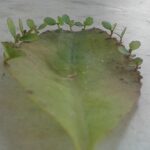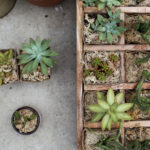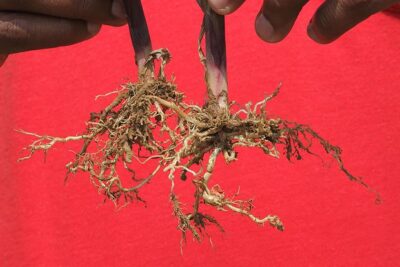
Can Succulent Leaves Regrow Once they Fall Off?

Succulents have become incredibly popular in recent years, adorning homes and gardens with their unique and beautiful foliage. One of the fascinating aspects of succulents is their ability to propagate and regrow from various parts of the plant. While many people are familiar with succulents' ability to grow new roots and shoots from cuttings, there is often confusion about whether succulent leaves can regrow once they fall off.
We will explore the regrowth potential of succulent leaves. We will discuss the different types of succulents that can regrow from fallen leaves, as well as the factors that influence their success. Additionally, we will provide some tips and techniques for propagating succulent leaves to maximize the chances of successful regrowth. Whether you are a seasoned succulent enthusiast or new to the world of succulents, this article will provide valuable insights into the regenerative capabilities of these unique plants.
- Yes, succulent leaves can regrow after falling off
- The fallen leaves can be propagated to grow new plants
- Place the fallen leaves on well-draining soil and mist occasionally
- Over time, new roots and baby plants will develop from the fallen leaves
- It may take several weeks or months for the new plants to fully grow
- Regular watering and indirect sunlight will help the regrowth process
- It is important to be patient and provide proper care for the fallen leaves
- Some succulent species are more likely to regrow from fallen leaves than others
- Experiment with different methods to find what works best for your succulents
- Enjoy the process of watching your fallen leaves transform into new plants
- Frequently Asked Questions
Yes, succulent leaves can regrow after falling off
One of the fascinating aspects of succulents is their ability to regenerate and propagate. If you've ever wondered whether succulent leaves can regrow once they fall off, the answer is a resounding yes!
When a succulent leaf falls off, it still retains the potential to develop into a whole new plant. This phenomenon, known as vegetative propagation, is a unique characteristic of succulents.
How does it work?
When a succulent leaf detaches from the plant, it contains specialized cells called meristematic cells. These cells have the remarkable ability to divide and differentiate into various tissues, eventually forming a new plant.
Once the leaf has fallen, it is crucial to allow it to callus over. This means that the wound where the leaf detached should dry out and develop a protective layer. This callus formation prevents the leaf from rotting and allows it to focus its energy on root and shoot growth.
 Succulent Pruning: Master the Art of Stem Cutting with Expert Tips
Succulent Pruning: Master the Art of Stem Cutting with Expert TipsMethods for regrowing succulent leaves
There are several methods you can employ to encourage regrowth from fallen succulent leaves:
- Leaf propagation: Simply place the fallen leaf on well-draining soil or a bed of succulent propagating mix. Ensure that the leaf is in contact with the soil or mix, as this is where the roots will emerge. Mist the leaf occasionally to maintain humidity and wait patiently for new roots and shoots to develop.
- Water propagation: Instead of planting the leaf directly into soil, you can place it in a dish or container with a small amount of water. Make sure only the base of the leaf touches the water, as the rest of the leaf may rot. Keep the water clean and change it regularly to prevent bacterial growth. Once the leaf develops roots, transfer it to soil for further growth.
- Leaf cuttings: For certain succulent species, you can cut a healthy leaf into smaller sections and plant them in soil. Each section has the potential to form a new plant. This method is commonly used for succulents with thick leaves, such as echeverias or sedums.
Patience is key
Regrowing succulent leaves requires patience and a bit of trial and error. Not all fallen leaves will successfully develop into new plants, but with time and proper care, you may be pleasantly surprised by the number of leaves that do regrow.
So, the next time you notice a fallen succulent leaf, don't discard it! Give it a chance to regenerate and witness the fascinating journey of new life emerging from a single leaf.
The fallen leaves can be propagated to grow new plants
One of the fascinating aspects of succulent plants is their ability to propagate and regrow from fallen leaves. These hardy plants have developed a unique survival mechanism that allows them to sprout new roots and grow into new plants from detached leaves.
When a succulent leaf falls off naturally or is carefully removed, it has the potential to regrow into a whole new plant. This process is known as leaf propagation, and it is a popular method among succulent enthusiasts to expand their collection or share their favorite varieties with others.
How does leaf propagation work?
Leaf propagation involves a few steps to ensure successful growth. Here's a breakdown of the process:
 Succulent Resilience: Regrowth After Cutting or Damage
Succulent Resilience: Regrowth After Cutting or Damage- Leaf selection: Choose a healthy, mature leaf from the succulent plant. Look for leaves that are plump, firm, and free from any damage or disease.
- Leaf detachment: Gently twist or wiggle the leaf until it separates from the stem. It's important to ensure that the entire leaf is intact, including the base or "heel" where it was attached to the stem.
- Callusing: Place the detached leaf in a dry and well-ventilated area, away from direct sunlight. Allow the leaf to callus for a few days or up to a week. This process allows a protective layer to form over the wound, preventing moisture loss and potential infections.
- Potting: Once the leaf has callused, prepare a well-draining potting mix suitable for succulents. Gently press the callused end of the leaf into the soil, ensuring it has good contact for rooting.
- Watering and care: Water the leaf moderately, keeping the soil slightly moist but not soggy. Place the potted leaf in a bright location with indirect sunlight. Avoid overwatering, as it can lead to rotting. Mist the leaf occasionally to maintain humidity.
- Root and plant growth: Over time, the callused end of the leaf will develop roots. These roots will eventually anchor the leaf into the soil. As the leaf takes root, a small rosette or cluster of new leaves will emerge from the base. This indicates successful propagation, and the new plant can be cared for like any other mature succulent.
It's important to note that not all succulent species have the same ability to regrow from fallen leaves. Some varieties, such as Echeverias and Sedums, are more prone to successful leaf propagation, while others may not produce viable offspring. Experimenting with different succulent types can be an exciting journey to discover which ones respond best to leaf propagation.
Leaf propagation offers a rewarding and cost-effective way to expand your succulent collection or share the beauty of these plants with others. With patience and proper care, you can witness the miraculous regrowth of a new succulent plant from a single fallen leaf.
Place the fallen leaves on well-draining soil and mist occasionally
One of the fascinating aspects of succulent plants is their ability to regenerate and grow from fallen leaves. If you've ever wondered whether succulent leaves can regrow once they fall off, the answer is a resounding yes! In fact, propagating succulents from fallen leaves is a popular method among plant enthusiasts.
To successfully regrow succulent leaves, it's crucial to provide them with the right conditions. Start by selecting healthy leaves that are fully intact and free from any signs of damage or disease. Once you have your chosen leaves, follow these steps:
Step 1: Prepare the soil
Choose a well-draining soil mix specifically formulated for succulents. It's important to ensure that the soil allows excess water to flow away easily, preventing the leaves from rotting. Fill a shallow tray or container with the soil, providing enough space for the leaves to lay flat without overlapping.
Step 2: Place the leaves
Gently place the fallen succulent leaves on top of the soil, ensuring that they make contact with the surface. Avoid burying the leaves as this can impede their ability to root and grow. Arrange them in a single layer, leaving some space between each leaf to prevent overcrowding.
 Can You Propagate Succulents by Growing New Plants from Leaves?
Can You Propagate Succulents by Growing New Plants from Leaves?Step 3: Mist occasionally
Misting the leaves with water helps to create a humid environment, promoting root development. However, it's important not to overwater as this can lead to rotting. Use a spray bottle to mist the leaves every few days or whenever the soil feels dry to the touch.
Tip: You can also place a clear plastic cover or a small propagating dome over the tray to create a mini greenhouse effect, maintaining moisture and humidity levels.
Over time, you will start to notice tiny roots emerging from the base of the leaves. These roots indicate that the leaves have successfully rooted and are ready to grow into new plants. It's essential to be patient during this process, as succulent leaf propagation can take several weeks to months.
Once the new plantlets have developed a substantial root system, you can gently transfer them to individual pots with well-draining soil. Treat them as you would any mature succulent, providing adequate sunlight, water, and occasional fertilization.
Succulent leaves have the remarkable ability to regrow once they fall off. By following the steps outlined above, you can enjoy propagating your own succulent collection and witnessing the miracle of new growth.
Over time, new roots and baby plants will develop from the fallen leaves
When caring for succulents, it is not uncommon for leaves to fall off due to various reasons such as natural shedding or accidental damage. But what happens to these fallen leaves? Can they regrow and thrive again?
 Propagating Succulents: A Guide to Using Aerial Roots for Growth
Propagating Succulents: A Guide to Using Aerial Roots for GrowthThe answer is yes! Succulent leaves have a remarkable ability to regenerate and regrow into new plants. This process is known as propagation, and it is one of the most fascinating aspects of succulent care.
How does it work?
When a succulent leaf falls off, it may appear lifeless and withered. However, hidden within the leaf are specialized cells called meristematic cells. These cells have the incredible capability to divide and differentiate into various plant tissues.
Once the fallen leaf comes into contact with a suitable growing medium, such as well-draining soil or water, the meristematic cells become activated. They start to produce new roots from the base of the leaf, anchoring it into the ground or water.
Simultaneously, the meristematic cells at the tip of the leaf begin to form a small bud or rosette. This bud will eventually develop into a baby plant, known as a pup or offset. As the pup grows, it will develop its own roots, leaves, and eventually become an independent succulent.
Propagation methods
There are a few different methods you can use to propagate succulent leaves:
- Leaf propagation: Simply place the fallen leaf on top of a well-draining soil mix, ensuring that the base of the leaf makes contact with the soil. Keep the soil slightly moist and provide indirect sunlight. Over time, new roots will form, and a baby plant will emerge.
- Water propagation: Instead of using soil, you can place the fallen leaf in a container with water. Ensure that only the base of the leaf is submerged. Change the water every few days to prevent rot. After a few weeks, roots will develop, and a new plant will start to grow.
- Leaf cutting propagation: With some succulent species, you can propagate by taking a healthy leaf from the parent plant and cutting it into smaller sections. Allow the cut ends to callus over for a few days, then plant them in well-draining soil. Each section has the potential to grow into a new succulent.
It's important to note that not all succulent leaves will successfully propagate. Some may not have enough energy or viable meristematic cells to regenerate. However, with proper care and patience, you can increase the chances of successful propagation.
Remember to provide the new plants with adequate light, water, and nutrients as they establish themselves. Over time, you'll witness the magic of succulent leaves regrowing into vibrant and thriving plants.
 Water Propagation: A Guide for Succulent Plants
Water Propagation: A Guide for Succulent PlantsIt may take several weeks or months for the new plants to fully grow
One of the common questions among succulent enthusiasts is whether succulent leaves can regrow once they fall off. The answer to this question is both fascinating and complex. While succulent leaves have the ability to regenerate and produce new plants, it is important to note that this process takes time and patience.
When a succulent leaf falls off or is gently removed from the mother plant, it has the potential to develop into a new plant through a process called propagation. Propagation is the method by which succulents reproduce and create new offspring.
Once the leaf is detached, it needs to undergo a period of drying and callusing, which typically takes a few days. During this time, the leaf forms a protective callus over the wound to prevent moisture loss and potential infections.
Once the leaf is callused, it can be placed on well-draining soil or in water to encourage root growth. This is where the regeneration process begins. The leaf starts to root and absorb water and nutrients to sustain itself.
After a few weeks, tiny new roots will start to emerge from the base of the leaf. This is an exciting stage as it indicates that the leaf is successfully establishing its root system. Once the roots have developed, the leaf will start to grow new leaves from its center.
It is essential to provide the newly propagated leaf with proper care and conditions during this growth phase. Adequate sunlight, well-draining soil, and regular watering (without overwatering) are crucial for the successful development of the new plant.
It is important to note that the regrowth process can vary among different succulent species. Some succulents may produce new plants more quickly, while others may take several months. Patience is key when it comes to succulent propagation.
 Growing Succulent Seeds at Home: A Step-by-Step Guide
Growing Succulent Seeds at Home: A Step-by-Step GuideSucculent leaves have the potential to regrow and develop into new plants through the process of propagation. However, this process requires time, patience, and proper care. So, if you find a fallen succulent leaf, don't be quick to discard it. Instead, give it a chance to regrow and witness the beauty of nature's resilience.
Regular watering and indirect sunlight will help the regrowth process
Regular watering and indirect sunlight are crucial factors in helping succulent leaves regrow once they fall off. Succulents are known for their ability to store water in their leaves, stems, or roots, which allows them to survive in arid conditions. When a succulent leaf falls off, it still retains some of that stored water and nutrients, making it possible for it to regrow.
However, it's important to note that not all succulent leaves have the ability to regrow. Some succulents, like Echeveria and Sedum, are known for their leaf propagation abilities. These types of succulents have leaves that can easily sprout new plants when placed in suitable conditions.
Steps to help succulent leaves regrow:
- Step 1: Gently remove the fallen leaf from the plant, making sure to keep the leaf intact. Avoid damaging the base of the leaf, as this is where new roots will form.
- Step 2: Allow the leaf to dry for a few days until a callus forms at the base. This callus will protect the leaf from rotting when it comes in contact with soil or water.
- Step 3: Prepare a well-draining potting mix suitable for succulents. A mix of sand, perlite, and peat moss works well.
- Step 4: Gently place the callused end of the leaf into the soil, ensuring it is partially buried but still exposed to light.
- Step 5: Water the soil lightly, making sure not to overwater. Succulents prefer dry conditions, so it's important to strike a balance between watering and allowing the soil to dry out between waterings.
- Step 6: Place the potted leaf in a location with indirect sunlight. Direct sunlight can scorch the leaf, hindering its regrowth process.
- Step 7: Be patient and wait for new roots and baby plants to emerge. This can take anywhere from a few weeks to a few months, depending on the succulent species.
Remember that not all succulent leaves will successfully regrow, and it may take some trial and error to achieve success. However, with the right care and conditions, you can increase the chances of regrowth and enjoy a thriving succulent collection.
It is important to be patient and provide proper care for the fallen leaves
Can Succulent Leaves Regrow Once they Fall Off?
One common question that succulent enthusiasts often have is whether or not fallen leaves can regrow. Succulents are known for their ability to propagate, and it is not uncommon for leaves to naturally fall off as part of their growth cycle. However, the potential for regrowth largely depends on the type of succulent and the care provided to the fallen leaves.
 How to Propagate a Rock Succulent by Splitting: Step-by-Step Guide
How to Propagate a Rock Succulent by Splitting: Step-by-Step GuideUnderstanding Succulent Propagation
Succulents have a unique ability to reproduce through various methods, including leaf propagation. When a leaf falls off a succulent plant, it is possible for it to develop roots and eventually grow into a new plant. However, not all succulent leaves have the same regrowth potential.
Factors Affecting Regrowth
There are several factors that can influence whether or not fallen succulent leaves will regrow. These factors include:
- Succulent Species: Different succulent species have different regrowth capabilities. Some species, such as Echeverias and Sedums, are known for their ability to easily propagate from fallen leaves. Others, like Haworthias, may have a lower success rate.
- Leaf Health: The health and vitality of the fallen leaf can also impact its regrowth potential. Leaves that are damaged or diseased may have a lower chance of regrowing compared to healthy leaves.
- Proper Care: Providing the right care to fallen leaves is crucial for their regrowth. This includes ensuring they have adequate sunlight, well-draining soil, and proper watering. Additionally, using a rooting hormone can help stimulate root growth and increase the chances of regrowth.
Patience is Key
It is important to note that regrowing succulent leaves requires patience. It can take several weeks or even months for roots to develop and new growth to emerge. During this time, it is crucial to provide consistent care and avoid disturbing the fallen leaves.
In Conclusion
 Can I Easily Propagate Succulents by Leaf Propagation?
Can I Easily Propagate Succulents by Leaf Propagation?While fallen succulent leaves have the potential to regrow, the success largely depends on the type of succulent and the care provided. By understanding the factors that influence regrowth and providing the proper care, you can increase the chances of successfully propagating new succulent plants from fallen leaves.
Some succulent species are more likely to regrow from fallen leaves than others
When it comes to succulents, one of the most fascinating aspects is their ability to propagate and regrow from fallen leaves. However, it's important to note that not all succulent species possess this remarkable characteristic. Some species are more likely to regrow from fallen leaves than others.
Generally, succulents that are part of the Crassulaceae family, such as jade plants (Crassula ovata) and mother of thousands (Kalanchoe daigremontiana), are known for their exceptional regrowth abilities. These plants have specialized cells in their leaves that allow them to produce new roots and eventually develop into new plants.
The Process of Succulent Leaf Regrowth
When a succulent leaf falls off or is gently removed from the mother plant, it doesn't necessarily mean the end of its life. In fact, this is just the beginning of its potential to regenerate and form a new plant.
Once the leaf has been detached, it's crucial to let the wound callus over before attempting to propagate it. This callus acts as a protective layer, preventing infections and promoting healthy growth. It usually takes a few days for the callus to form, depending on the environmental conditions.
After the callus has formed, the leaf can be placed on a well-draining soil mix or directly on top of the soil. It's essential to provide the leaf with indirect sunlight and proper moisture to encourage root development. Avoid overwatering, as this can lead to rotting instead of regrowth.
Over time, tiny roots will emerge from the base of the leaf, gradually anchoring it into the soil. As the roots develop, a new rosette or cluster of leaves will start to grow from the original leaf's base. This process can take several weeks or even months, depending on the species and environmental conditions.
 Water Propagation of Succulents: A Comprehensive Guide
Water Propagation of Succulents: A Comprehensive GuideFactors Influencing Succulent Leaf Regrowth
While many succulent species have the potential to regrow from fallen leaves, several factors can influence the success of this process.
- Species: As mentioned earlier, not all succulent species have the same regrowth capabilities. Some species, like echeverias, may not readily propagate from fallen leaves.
- Leaf Health: The overall health and condition of the leaf play a significant role in its ability to regenerate. Leaves that are damaged or diseased may not successfully regrow.
- Environmental Conditions: Factors such as temperature, humidity, and light intensity can impact the success of succulent leaf regrowth. Optimal conditions for each species should be provided to ensure the best chances of regrowth.
- Care and Maintenance: Proper care and maintenance, including adequate watering, well-draining soil, and periodic fertilization, can contribute to the successful regrowth of succulent leaves.
It's important to remember that while succulent leaf propagation can be an exciting and rewarding experience, not all leaves will successfully regrow. Experimentation and patience are key when attempting to propagate succulents from fallen leaves.
So, if you find fallen succulent leaves, don't hesitate to give them a chance to regrow. You might be amazed by the resilient nature of these plants and the beauty they can bring to your succulent collection.
Experiment with different methods to find what works best for your succulents
When it comes to succulents, one of the most fascinating aspects is their ability to regrow from fallen leaves. This unique characteristic has sparked the curiosity of many plant enthusiasts, leading them to experiment with different methods to see if they can successfully propagate new plants from these fallen leaves.
While not all succulent leaves have the ability to regrow, many species do possess this remarkable trait. If you're interested in trying your hand at propagating succulents from fallen leaves, it's important to understand the process and explore the various methods that can be used.
Leaf Propagation: A Step-by-Step Guide
1. Choose healthy leaves: Select leaves that are fully grown and free from any damage or disease. Gently twist or cut the leaf from the stem, ensuring you have a clean break.
 Dormancy in Succulents: A Guide to Varieties and Timing
Dormancy in Succulents: A Guide to Varieties and Timing2. Let the leaf callus: Place the leaves in a warm and dry location, away from direct sunlight. Allowing the cut end of the leaf to callus over is crucial for successful propagation. This can take anywhere from a few days to a couple of weeks, depending on the succulent species.
3. Prepare the potting mix: While the leaf is callusing, prepare a well-draining potting mix suitable for succulents. You can create your own mix by combining equal parts of perlite, sand, and potting soil.
4. Plant the leaf: Once the leaf has formed a callus, gently press the cut end into the prepared potting mix. Ensure that the leaf is not planted too deeply, as this can hinder its ability to root and regrow.
5. Water sparingly: After planting the leaf, water it lightly to settle the soil. However, it's important to avoid overwatering, as succulent leaves are prone to rot if kept too moist. Allow the soil to dry out between watering sessions.
6. Provide indirect sunlight: Place the potted leaf in an area that receives bright but indirect sunlight. Avoid exposing it to direct sunlight, as this can scorch the leaf and inhibit its growth.
7. Be patient: Over time, you may begin to see small roots emerging from the cut end of the leaf. This indicates that the leaf has successfully rooted and is on its way to regrowing into a new succulent plant. It's important to be patient throughout this process, as it can take several weeks or even months for a new plant to fully form.
Alternative Methods of Propagation
While leaf propagation is the most common method, there are other ways to propagate succulents as well:
- Stem cuttings: Instead of using individual leaves, you can cut a section of the stem and plant it in a similar manner as leaf propagation.
- Offsets: Some succulents produce small offshoots, also known as pups, around the base of the plant. These can be carefully separated and planted to create new plants.
- Division: For succulents that have multiple rosettes or clusters, you can divide the plant by carefully separating the individual rosettes and potting them separately.
By experimenting with these different propagation methods, you can discover which works best for your specific succulent species. Remember to provide proper care and patience during the process, and soon enough, you'll have a collection of beautiful new succulent plants grown from fallen leaves or other propagation techniques.
Enjoy the process of watching your fallen leaves transform into new plants
Enjoy the process of watching your fallen leaves transform into new plants
One of the fascinating aspects of owning succulents is their ability to grow new plants from fallen leaves. If you've ever wondered whether succulent leaves can regrow once they fall off, the answer is a resounding yes!
When a succulent leaf drops from the plant, it may seem like a loss. However, this is just the beginning of an incredible journey. These fallen leaves have the potential to sprout roots and develop into new, independent succulent plants, a process known as propagation.
How does it work?
When a succulent leaf is detached from its parent plant, it retains its ability to photosynthesize and extract nutrients from the surrounding environment. Over time, the base of the leaf will begin to form calluses, which serve as the foundation for root development.
As the callus forms, tiny roots emerge and begin to grow into the soil or substrate. This is the first sign that the leaf is successfully regrowing. Gradually, a tiny rosette of leaves will emerge from the top of the leaf, signaling the plant's growth and development.
Optimal conditions for leaf propagation:
- Choose healthy leaves: Select leaves that are plump, firm, and free from any signs of damage or disease.
- Allow the leaf to callus: Place the leaf in a warm, dry location and let it callus for a few days to a week. This will prevent the leaf from rotting when it comes into contact with moisture.
- Provide well-draining soil: Plant the callused leaf in a well-draining soil mix or a suitable succulent/cactus mix. This will prevent waterlogged conditions that can lead to root rot.
- Water sparingly: While the regrowing leaf needs some moisture to support root development, it's crucial not to overwater. Wait until the soil is dry before watering, and avoid excessive moisture.
- Provide ample light: Succulents thrive in bright, indirect light. Place the newly planted leaf in a location where it will receive adequate sunlight.
Patience and excitement
Leaf propagation is a slow process that requires patience. It may take several weeks or even months for the leaf to fully develop into a new plant. However, the wait is worth it, as you get to witness the miracle of nature unfold.
Watching a tiny rosette emerge from a once-fallen leaf is an exciting and rewarding experience for succulent enthusiasts. Not only does it provide a sense of accomplishment, but it also allows you to expand your succulent collection without having to purchase new plants.
So, the next time you notice a succulent leaf has fallen off, don't be disheartened. Instead, embrace the opportunity to witness the regrowth and transformation of your fallen leaf into a brand new succulent plant!
Frequently Asked Questions
1. Can succulent leaves regrow once they fall off?
Yes, many succulent leaves have the ability to regrow into new plants through a process called propagation.
2. How do I propagate succulent leaves?
To propagate succulent leaves, simply remove a healthy leaf from the plant, let it dry for a few days, and then place it on well-draining soil. Keep the soil slightly moist and wait for new roots and a baby plant to form.
3. How long does it take for succulent leaves to regrow?
The time it takes for succulent leaves to regrow varies depending on the type of succulent and environmental conditions. On average, it can take a few weeks to a few months for new plants to develop.
4. Can I regrow succulent leaves in water?
While some succulent leaves can be propagated in water, it is generally recommended to use well-draining soil for better success. Water propagation can lead to rot or weak root development in some succulent species.
If you want to read more articles similar to Can Succulent Leaves Regrow Once they Fall Off?, you can visit the Propagation category.






You Must Read